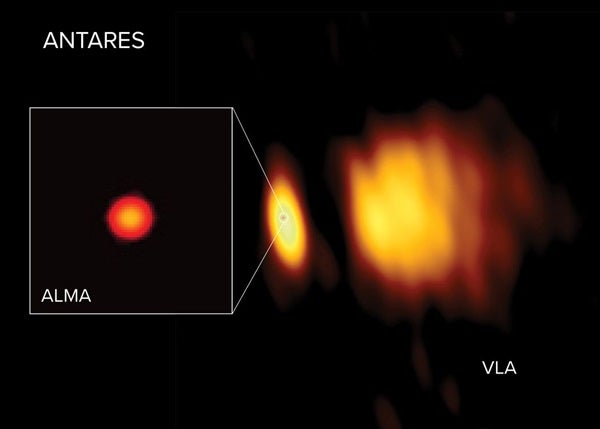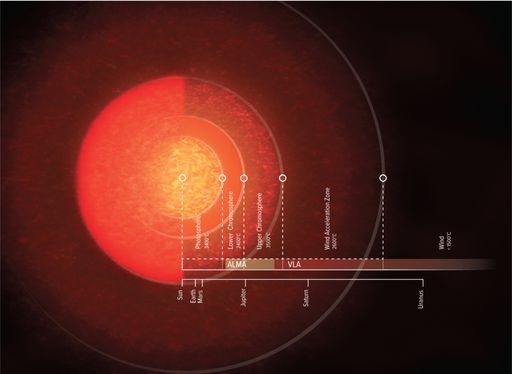The Atacama Large Millimeter/submillimeter Array (ALMA) observed Antares’ optical photosphere, close to the surface of the star while the Very Large Array (VLA) revealed the outer layers of the star’s atmosphere. With VLA, astronomers also saw a huge gust of stellar wind (visible on the right) that had been launched from Antares and was lit up by the star’s smaller, hotter companion Antares B.
Sparkling near the heart of the constellation Scorpius lies ruby-red Antares, the 15th-brightest star in the night sky. Like its bloated cousin Betelgeuse, Antares is a red supergiant nearing the end of its life. These enormous yet relatively cold stars sport strong stellar winds that fire heavy elements like carbon and nitrogen into space, providing many of the building blocks for life as we know it.
Exactly how these winds are cast off has largely remained a mystery — but it might not stay that way for long. Thanks to both the Atacama Large Millimeter/submillimeter Array (ALMA) and the National Science Foundation’s Karl G. Jansky Very Large Array (VLA), astronomers have peered deep within the atmosphere of Antares, and the insights their observations reveal help bring them one step closer to solving the mystery of superpowered winds from supergiant stars.
A new puzzle piece found
The two radio telescopes revealed that Antares is even larger than we previously believed. In visible light, the star is about 700 times larger than the Sun. But when ALMA and VLA looked at it in radio light, they saw that the star’s chromosphere — the second of a star’s three main atmospheric layers — extended out some 2.5 times the star’s radius. For comparison, the Sun’s chromosphere extends only 1/200 of its radius.
The temperature of Antares’ chromosphere, on the other hand, is much lower than the Sun’s. Observations in radio light revealed that the area only peaks at about 6,300 degrees Fahrenheit (3,500 degrees Celsius), whereas the Sun’s chromosphere reaches temperatures of nearly 36,000 F (20,000 C).
“We think that red supergiant stars, such as Antares and Betelgeuse, have an inhomogeneous atmosphere,” said co-author Keiichi Ohnaka in a press release from the National Radio Astronomy Observatory (NRAO). “Imagine that their atmospheres are a painting made out of many dots of different colors, representing different temperatures. Most of the painting contains dots of the lukewarm gas that radio telescopes can see, but there are also cold dots that only infrared telescopes can see, and hot dots that UV telescopes see.”
Thanks to this data, scientists were able to see a clear distinction between the chromosphere and the solar-wind-forming region.
“Our innate understanding of the night sky is that stars are just points of light,” said NRAO astronomer Chris Carilli in the same press release. “The fact we can map the atmospheres of these supergiant stars in detail is a true testament to technological advances in interferometry. These tour de force observations bring the universe close, right into our own backyard.”











